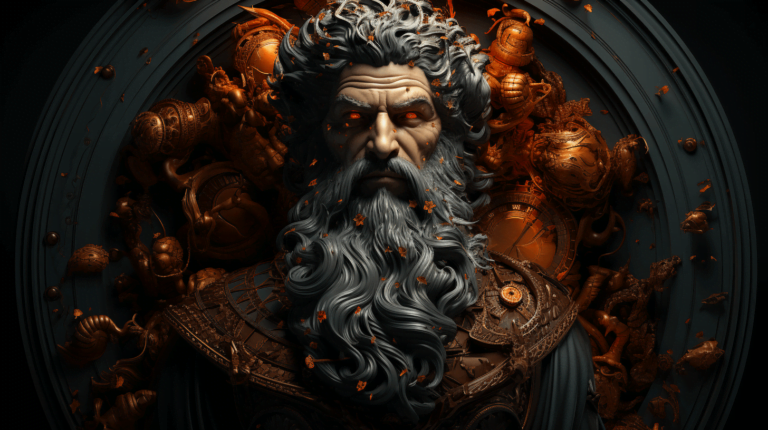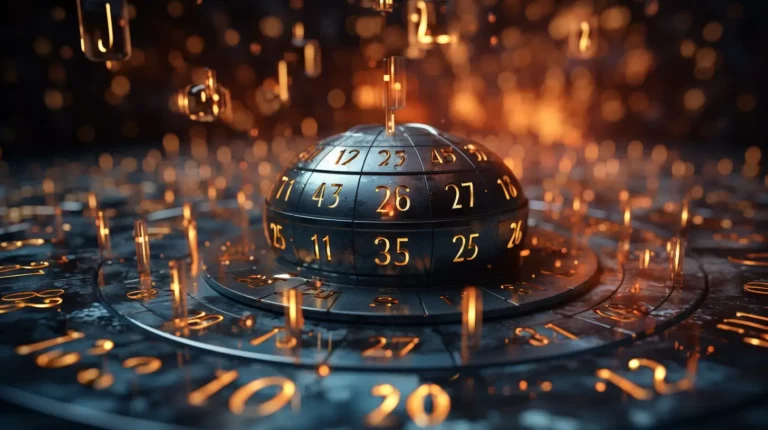Journey to the Monad: Pathways to Universal Unity
Preface
Welcome to the enigmatic and profound journey into the heart of the Monad, a concept that transcends the boundaries of philosophy, theology, and science, weaving a mosaic of mystical understanding that has captivated seekers of wisdom through the ages. This guide is an invitation to explore the depths of a principle that is as elusive as it is fundamental, a singular source from which the myriad complexities of existence flow.
The Monad, in its most quintessential form, represents the unity of all things, the origin from which multiplicity emerges and to which it eventually returns. It is the undivided, the unmanifest, the absolute from which the cosmos dances into being. In the words of the Gnostic scriptures,
“Before all things were, there was Monad, ineffable in its simplicity.”
This echoes the timeless quest for understanding the One, the uncaused cause, the prime mover.
In the Pythagorean tradition, the Monad is the beginning, the very essence of number, from which the sequence of existence unfolds. Neoplatonism, with its mystical inclinations, viewed the Monad as the ultimate principle, the Good, the One, from which emanates the Nous (Divine Mind), the Soul, and the material world.
The Monad represents the primal source of all things, the singularity from which all diversity springs forth. It is the seed of existence, the unity before duality, and the foundation of all numerical and metaphysical principles. In esoteric terms, the Monad is the purest essence, untainted and whole, the point of origin for all creation.
To understand the Monad, think of it as the singular spark of consciousness from which the flame of life ignites. It is the ineffable point of unity, the first cause that precedes all subsequent effects.
As Plotinus, a prominent Neoplatonist philosopher, eloquently stated,
“The One is all things and no one of them; for the source of all things is not all things; and yet it is all things in this sense, that they all exist by reason of the One.”
In Neoplatonism, the Monad, or the One, is often described in terms of its emanative process. From the Monad flows the Nous, or Divine Mind, which holds the archetypal ideas and forms. The Nous then gives rise to the Soul, the intermediary between the higher spiritual realms and the physical world. Finally, the material world is born, manifesting the multiplicity that springs from the initial unity of the Monad.
Plotinus further illustrates this emanative process:
“The One, as it were, overflows, and its superabundance makes another, and this is the Nous.”
This flow from the One to the Many is a key principle in Neoplatonic thought, emphasizing the interconnectedness of all levels of reality.
To put it simply, the Monad is the source, the first principle, the divine unity from which everything emerges. It is the hidden root of existence, the silent origin that holds within it the potential of the entire cosmos. As Pythagoras famously remarked, “All is number,” signifying the profound truth that the essence of all things can be traced back to this singular, mystical point.
Gnosticism, steeped in its esoteric and mystical roots, revered the Monad as the supreme and transcendent deity, beyond the grasp of human understanding and yet intimately connected to the innermost spirit of every individual. It is said,
“The Monad is a monarchy with nothing above it. It is he who exists as God and Father of everything, the invisible One who is above everything.”
This guide aims to explore these rich and diverse perspectives, delving into the heart of what it means to understand and experience the concept of the Monad. We will traverse the realms of philosophy, theology, science, and mysticism, seeking to uncover the layers of meaning and insight that the Monad offers.
In the spirit of the ancient wisdom, let us begin our journey with an open mind and a willing heart, guided by the words of the Hermetic tradition:
‘That which is Below corresponds to that which is Above, and that which is Above corresponds to that which is Below, to accomplish the miracle of the One Thing.’
Thus, as above, so below; as within, so without; in the exploration of the Monad, we explore the universe and ourselves.”
Chapter 1:
The Monad in Philosophy
In the ancient tradition of Pythagoreanism, founded by the legendary philosopher Pythagoras, the Monad is revered as the starting point of all existence. It represents not just unity, but the very essence of unity from which the sequence of numbers and, by extension, the order of the universe emerges. Pythagoras famously declared, “All is number,” and in this cosmic scheme, the Monad stands as the numeral one, the symbol of oneness and harmony.
This numeral one, or the Monad, is not merely a number in the conventional sense. It is the principle of order and harmony in the cosmos. The Pythagoreans viewed the universe as an embodiment of mathematical principles, with the Monad being the key that unlocks the mysteries of the universe. It is the source of all numbers, and thus, of all forms and realities.
In Pythagorean thought, the progression from the Monad leads to the Dyad (the number two), representing duality and multiplicity. Yet, these subsequent numbers always trace back to the Monad, the source of their existence. The Monad is thus seen as the beginning, the first cause, an indivisible and infinite point from which the continuum of reality unfolds.
Similarly, in Taoist philosophy, the concept of zero, or the void, plays a crucial role. The Tao, often translated as “The Way,” is the fundamental principle that underlies and unites all things. The Tao Te Ching, attributed to Laozi, speaks of the Tao as the origin of everything, yet it is described as empty, void, and nothing. Laozi states,
“The Tao that can be told is not the eternal Tao; the name that can be named is not the eternal name. The nameless is the beginning of heaven and earth.”
In this context, zero represents the undifferentiated void, the potential from which all existence arises. It is akin to the Monad in that it is the source, the unifying principle from which multiplicity emanates. Just as the Monad is the first cause in Pythagoreanism, the Tao is the primordial essence in Taoism.
The connection between the Monad and the Taoist zero lies in their shared understanding of unity and origin. The Monad, as the numeral one, can also be seen as zero in the sense that it embodies nothingness, the pure potentiality before differentiation. Laozi poetically captures this concept:
“The Tao is empty but inexhaustible, bottomless, the ancestor of it all.”
Thus, the Monad in Pythagorean thought and the zero in Taoism both symbolize the ultimate reality from which everything springs. They are the points of origin, embodying both unity and the void, the fullness of potential and the emptiness from which the cosmos unfolds. This profound intersection highlights the universal quest to understand the source of existence and the nature of reality.
In summary, the Monad and the Taoist zero are not merely abstract concepts but profound symbols of the unity and nothingness that lie at the heart of all creation. They remind us that in the depths of the void, in the singularity of the one, lies the infinite potential of the universe.
Let’s go through a few points again to make it clearer.
Neoplatonism, a philosophical system developed in the 3rd century by Plotinus, the concept of the Monad evolves and deepens, mirroring our own journey of self-discovery and understanding. In Neoplatonism, the Monad, identified with ‘The One’ or ‘The Good’, stands as the ultimate principle of reality, existing beyond all categories of being and non-being. Plotinus poetically describes it:
“The One is all things and no one of them; the source of all things is not all things; all things are its possession, coming from it, but it is not the sum of all things.”
Here, the Monad transcends the highest forms of intellect and existence, embodying the cause of all life while itself remaining uncaused. From this primordial One emanates the Nous, or Divine Mind, the first manifestation of unity. Following this, the World Soul emerges, leading to the creation of the material world. This process is not creation in the conventional sense but rather an overflowing of the One’s abundance, mirroring our own potential to grow and overflow with compassion and understanding.
This concept resonates with the mystical aspects of Gnosticism, where the Monad is seen as the ultimate, unknowable source. A Gnostic text reflects:
“From the One, the Ineffable, comes the procession of the world of multiplicity.”
The Gnostics believed that grasping the nature of the Monad and its emanation is crucial for spiritual enlightenment and a return to the divine source. This belief underscores a broader truth applicable to our lives: while the origins of existence might remain shrouded in mystery, what is clear is our capacity for compassion and mutual support. This is the essence of our shared humanity.
In the realms of the occult and mysticism, the Monad symbolizes not merely a philosophical idea but a gateway to deeper spiritual wisdom. It represents the unity between the microcosm (the individual) and the macrocosm (the universe). The quest to understand the Monad is, fundamentally, a journey inward—a process of self-realization and cosmic awareness that teaches us the importance of integrating the disparate parts of our psyche.
Echoing the Hermetic tradition with its principle “As above, so below,” the Monad, in its state of pristine unity, reflects the interconnectedness of all things. Such pursuit invites us to reflect on the profound implications of unity and source, guiding us to a deeper understanding of ourselves and the universe. Through understanding and quieting our minds, we aim to heal the splits in our psyche, achieving a state of peace and wholeness.
Thus, the Monad stands as a beacon of wisdom, guiding us on our journey through the intricate paths of philosophy, spirituality, and mystical enlightenment. It is a call to contemplate the unity and source of all that exists, leading us to foster compassion and support among each other as we navigate the complexities of life.
Chapter 2:
The Monad in Gnosticism
In the mystical landscape of Gnosticism, an ancient religious movement with profound spiritual and philosophical dimensions, the Monad is revered as the transcendent and ultimate essence of God. This ineffable presence transcends what is known and knowable, residing beyond the physical and material realms. Central to Gnostic thought is the pursuit of gnosis, a direct, personal, and mystical knowledge of the divine, with the Monad as its focal point.
The Monad in Gnosticism embodies the very essence of the highest divine reality. Described in Gnostic texts as the ‘Forefather’ and the primal origin, it is considered the cause of all causes. The Gnostic Gospel of Thomas captures this essence:
“The Monad is the source, silent, still, and perfect in its eternity.”
Gnostic cosmology features a rich mosaic of emanation, reminiscent of Neoplatonism but with its unique intricacies. From the Monad flows a hierarchy of divine beings or aeons, each reflecting an aspect of divine nature. These aeons exist within the Pleroma—the fullness of divine presence—and represent the Monad’s attributes.
Let’s explore the concept of the Pleroma a bit further. To deepen our understanding, we will refer to Carl Jung’s insights from his work “Seven Sermons to the Dead,” where he elaborates on the nature of the Pleroma.
The Pleroma: This term is borrowed from Gnosticism and essentially means “fullness” or “wholeness”. In Jung’s sermon, Pleroma is described as a state of complete emptiness and fullness. It is everything and nothing at the same time, a void that is also the origin of all existence. Jung argues that we come from the Pleroma and return to it after death. It’s a state where opposites cease to exist because they cancel each other out.
Principle of the Opposites: Jung emphasizes that the world as we know it exists because of differentiation from the Pleroma, and that differentiation is characterized by the opposites. Everything we perceive is based on the contrast of opposites. For instance, we can only perceive light because we know what darkness is.
Jung also suggests that human desire for unity or the ‘God’ within us is what draws us back to the Pleroma. However, he warns that the undifferentiated state is not preferable while we are alive because it is equivalent to death. The goal, instead, is to acknowledge and balance the opposites within us without being consumed by any one side.
Central to the Gnostic belief is the notion that within every human being lies a divine spark, a fragment of the Monad’s light, obscured by the material world’s illusions and ignorance. The Gnostic journey involves awakening this divine spark and guiding it back to its source in the Monad. A Gnostic text expresses this path:
“The divine spark within, the inner light, is our true guide to the Monad, the ultimate God.”
Gnosticism introduces the Demiurge, a lesser deity who crafts the material world, often perceived as imperfect or malevolent. Unaware of the higher realm of the Monad, the Demiurge strives to keep human souls tethered to the material. In contrast, the Monad symbolizes the transcendence of material illusion and the realization of spiritual truth.
The human soul’s struggle, according to Gnosticism, is to break free from the Demiurge’s deceptive world and return to the Monad—a journey of spiritual awakening and liberation, as the teachings state:
“To know the Monad is to break free from the chains of the Demiurge’s world.”
Following these insights into Gnosticism, we can draw a poignant parallel to the modern human condition. The figure of the Demiurge, who crafts an imperfect world and perpetuates ignorance, finds a troubling echo in contemporary society.
With our world rife with conflict, hate, and psychological division, one might argue that humans themselves can embody aspects of the Demiurge. Through wars, intolerance, and the various delusions that plague our collective psyche, we contribute to a metaphorical second deluge—an overwhelming flood of negativity and destruction.
This perspective urges us to heed the ancient Gnostic imperative to “know thyself.” By understanding our inner worlds and the shadows within our psyches, we can begin to break free from the cycles of harm and illusion that bind us.
Compassion for others, and a commitment to end conflicts and crimes, are not just moral choices but vital steps toward spiritual and global healing. Only through deep self-awareness and genuine empathy can we hope to avoid the fate of those ensnared by the Demiurge’s world.
As we strive to transcend these limitations, we mirror the Gnostic soul’s journey back to the Monad, moving toward a collective liberation from the chains of our lesser nature. It’s a call for an urgent reassessment of our actions and values—before it’s too late.
The Monad in the realm of the occult symbolizes ultimate unity and the source of esoteric wisdom, representing the hidden knowledge that transcends ordinary understanding—a secret key to spiritual enlightenment. The pursuit of this knowledge is a quest for deeper truths about the universe and our role within it.
The Gnostic view of the Monad underscores the soul’s inner journey toward discovering the divine within and realizing our connection to the ultimate source. This path is marked by introspection, meditation, and the cultivation of gnosis—the knowledge of spiritual truths.
Echoing the wisdom of Rumi, “The wound is the place where the Light enters you,” this conception invites us to recognize our challenges and suffering as opportunities for spiritual enlightenment and growth.
Similarly, philosopher Alan Watts reminds us, “You’re under no obligation to be the same person you were five minutes ago,” suggesting that our journey towards the divine is one of continual transformation and self-discovery.
From a psychological perspective, our exploration of the Monad also reflects the journey toward integrating the various parts of our psyche, healing the splits that obscure our inner light. In this process, we learn the importance of compassion—recognizing that just as some act as the Demiurge, imposing control and fear, we have the potential to uplift and assist one another.
Thus, the Gnostic Monad serves as a beacon of spiritual liberation, guiding us toward the awakening of our truest, most divine selves, and encouraging us to help each other, elevate our collective consciousness, and heal together. In embracing these teachings, we not only pursue personal enlightenment but also contribute to the collective spiritual journey of humanity.
Chapter 3:
Leibniz’s Monadology
Gottfried Wilhelm Leibniz, a preeminent philosopher and mathematician, introduced a groundbreaking perspective on the nature of reality through his Monadology. In this philosophical framework, Monads are the fundamental, indivisible, and simple entities that constitute the fabric of the universe. These Monads are not physical in nature; rather, they are metaphysical points of force or energy, each reflecting the entire universe in a unique way.
Leibniz describes Monads as “windowless”, meaning they do not interact with each other through physical means but are in a state of pre-established harmony orchestrated by the divine. Every Monad contains within it a unique perspective of the universe, and though they do not interact directly, they are synchronized in a way that creates the coherent reality we experience. Leibniz states,
“Monads are the real atoms of nature and, in a word, the elements of things.”
In Leibniz’s view, Monads are characterized by their ability to perceive and to desire. Perception in Monads is not sensory as in humans, but a form of internal representation of the universe. Each Monad mirrors the universe in its own way, based on its perspective and capacity. This perception leads to appetition, the Monad’s drive to move from one state of perception to another, creating a dynamic, ever-changing reality.
Leibniz’s philosophy posits that there is a hierarchy of Monads, with the simplest possessing the most basic perceptions and the most complex (like human souls) having the most detailed and distinct perceptions. At the pinnacle of this hierarchy is the Supreme Monad or God, who perceives all and harmonizes the entire universe in a perfect balance.
In occult philosophy, Leibniz’s concept of Monads resonates deeply. The idea that each Monad reflects the whole universe aligns with the Hermetic principle of “As above, so below.” This suggests a microcosmic and macrocosmic correlation, where understanding the nature of a single Monad can lead to understanding the greater cosmos.
The Monads, in their state of pre-established harmony, echo the occult belief in a cosmic order that is both mysterious and profound. They represent the unseen forces that weave the fabric of reality, hinting at a deeper, hidden structure to the universe that is accessible through spiritual insight and esoteric knowledge.
While Leibniz’s Monadology differs significantly from Gnostic thought, there are intriguing parallels in their understanding of a complex, layered reality. Both systems speak of a reality that is more than meets the eye, a deeper truth behind the facade of the material world. In Gnostic terms, understanding the nature of the Monad and its emanations could be likened to understanding the Monads of Leibniz – keys to unlocking the mysteries of the universe.
Building on Leibniz’s Monadology, the concept of Monads offers a profound lens through which to explore the notion of individuality and interconnectedness in our universe. Monads, as indivisible and unique reflections of the universe, bring forth the idea that each of us harbors a universe within, a solitary perspective that is both isolated and yet perfectly synchronized with the whole.
When we close our eyes and retreat into our inner selves, the only presence we truly encounter is our own. This introspection leads us to question: Who is really here? Who is truly everywhere? Like the prophets—Moses, Jesus, Muhammad—whose divine encounters were deeply personal and individual, manifesting as voices from within, we too experience life through our internal dialogues and perceptions. These experiences, though deeply personal, are not dissimilar from those around us, reflecting a shared reality.
This realization brings to light the paradox of our existence: in our isolation, we are deeply connected. Just as each Monad in Leibniz’s philosophy does not physically interact yet remains part of a grand orchestral harmony, so too are we, in our solitude, part of a larger, interconnected human experience.
How long, then, shall we continue to see division where there is unity? How long will we act against one another, when such actions are ultimately against ourselves? In the spirit of the Monad, each action towards another is an action towards the whole, towards ourselves. We are urged to recognize that when we harm another, we harm the unified fabric of which we are all a part.
The call for compassion is not just a moral injunction but a metaphysical imperative rooted in the very nature of our existence. To be compassionate is to recognize and honor the Monad within each of us—to see the reflection of the whole universe in every individual and to treat each being as we would treat ourselves. There is no “other” in this deeply interconnected cosmos; there is just the One, the Zero—the essential unity from which we all emanate.
Chapter 4
The Magician’s Journey
In Tarot, the Magician stands as a powerful symbol of manifestation, resourcefulness, and potential. This archetypal figure, embodies the principle of conscious awareness and the ability to harness the elemental forces of nature to bring about change. In the context of our journey towards understanding and reaching the Monad, the Magician’s path serves as a metaphorical guide, illustrating how we might navigate the complex interplay of the metaphysical and the material to touch the essence of the Monad.
The Magician’s journey in the Tarot is a profound allegory for mastery over the multiple dimensions of human experience, symbolized by the four suits of the Tarot deck: wands, cups, swords, and pentacles. Each suit represents a distinct aspect of life, offering a comprehensive view of our existence.
- Wands: Creativity and Will – The suit of wands is emblematic of the element of fire. It represents our inner spark, the driving force of creativity, ambition, and willpower. When the Magician aligns with the energy of wands, it signifies the harnessing of one’s personal power to initiate action and bring about change. This suit challenges us to tap into our passion, to kindle the flames of inspiration and courage, and to direct our energies towards the realization of our goals and dreams.
- Cups: Emotions and Intuition – Represented by the element of water, the cups symbolize the realm of emotions, feelings, relationships, and intuition. The Magician’s journey through the cups involves navigating the depths of the emotional and intuitive self. It calls for an understanding and harmonizing of our inner emotional landscape—acknowledging and processing feelings, developing empathy, and fostering meaningful connections. This suit emphasizes the importance of emotional intelligence and the value of listening to our intuitive inner voice.
- Swords: Intellect and Reason – Associated with the element of air, swords reflect the power of the mind, encompassing intellect, reason, and communication. The Magician’s interaction with swords is about mastering the mental realm—critical thinking, decision-making, and clear communication. It involves cutting through illusion and deceit to see the truth and using intellectual power responsibly. This journey encourages the development of a sharp and discerning mind, capable of navigating complex ideas and concepts.
- Pentacles: Material and Physical Aspects – Grounded in the element of earth, pentacles are concerned with the material and physical aspects of life. This includes our relationship with our body, our environment, and our finances. The Magician’s path through pentacles is a call to cultivate a balanced and pragmatic approach to the material world. It involves recognizing the value of hard work, the importance of stability and security, and the need for a harmonious relationship with the physical realm.
In mastering these four suits, the Magician embodies the holistic integration of all aspects of being. Through this journey, the Magician becomes a symbol of unity and wholeness, embodying the harmonious interplay of creativity, emotion, intellect, and materiality.
As one advances along the Magician’s path, mastering the four elemental aspects of the Tarot—Wands, Cups, Swords, and Pentacles—is essential. Each suit represents a vital component of our existence and personality. Mastery of these elements is the foundation upon which one can transcend the multiplicity of being.
In transcending, one must let go of the ego and the individual mind to merge with the universal consciousness. This ascension toward the Monad is not merely an external journey but a profound inward exploration. As Rumi wisely stated,
‘You are not a drop in the ocean. You are the entire ocean in a drop.’
Before one can transcend, however, mastery over these diverse aspects of self is imperative. Trust the flow, embrace the way, preparing the soul for its ultimate return to unity.
The psyche, according to psychoanalytic theory, is composed of various elements—each with its own needs, desires, and viewpoints. These elements can be seen as separate personalities within us, often conflicting and competing for dominance.
For instance, one part might seek safety and comfort, while another craves adventure and risk. Another might strive for moral goodness, while yet another could succumb to baser instincts. These splits in the psyche can lead to internal conflicts and dissonance, making it challenging to feel whole or at peace.
The task of unifying these disparate parts is akin to the Magician’s quest to ascend toward the Monad—the ultimate symbol of unity and oneness. The process involves acknowledging and embracing the diversity within oneself, allowing each part to express itself and contribute to the whole without overwhelming it.
This can be achieved through various therapeutic techniques such as Jungian integration, where the goal is to bring the unconscious aspects of oneself into consciousness, allowing for a harmonious coexistence of all parts.
Mindfulness and meditative practices also play a crucial role in this integration. By observing one’s thoughts and feelings without judgment, one can begin to understand the underlying needs and fears that drive different behaviors and attitudes. This understanding opens the door to compassion for oneself, and gradually, the inner conflicts begin to ease as the disparate parts learn to work together rather than against each other.
The journey towards inner unity is ongoing and dynamic. Just as the Magician uses tools and symbols to achieve transformation, individuals can use psychological tools and spiritual practices to foster greater integration within their psyche.
This path not only leads to personal peace and wholeness but also enhances one’s ability to relate to others and the world in a more balanced and harmonious way. In this sense, the ascent towards the Monad becomes not just a personal journey, but a collective one, where the unity achieved within oneself reflects and contributes to the unity of all existence.
In the context of the Magician’s journey, reaching the Monad represents achieving a state of complete harmony and alignment with the fundamental forces of the universe that are within your psyche—remember, ‘as above, so below.’ It is about realizing one’s full potential as a co-creator with the divine, harnessing the power of consciousness to manifest one’s highest aspirations and contribute to the greater good of all.
The movement towards the Monad is a journey of healing and wholeness. In a world often characterized by fragmentation and disconnection, the Monad stands as a symbol of the underlying unity of all things. By moving towards the Monad, we seek to heal the divisions within ourselves and in our world, to restore a sense of balance and harmony.
The Magician’s journey through the Tarot towards the Monad is a symbolic representation of our own spiritual journey. It is a path of self-discovery, mastery, and ultimately, a return to the source of all being. This journey is not linear but cyclical, mirroring the eternal cycles of birth, death, and rebirth that characterize the natural world.
By mastering the four suits of the Tarot—wands, cups, swords, and pentacles—the Magician achieves a holistic integration, symbolizing the unity of diverse aspects of existence. This process is akin to the harmony within Leibniz’s Monadology, where each Monad, unique and distinct, reflects the whole universe from its perspective.
Imagine if each of us is here to perfect a specific aspect of these elemental forces. Some individuals might be naturally attuned to the fiery energy of action and creativity (wands), while others resonate more with the emotional and intuitive depth of cups.
Some might find their strength in the intellectual rigor and clarity of swords, and others in the grounded, tangible realm of pentacles. Each person, endowed with innate gifts and inclinations towards certain elements, contributes uniquely to the collective human experience.
In this framework, our individual journeys of mastery are not isolated pursuits but interconnected paths towards a collective goal. The person strong in the ways of wands may inspire and energize those around them, igniting creative passions and encouraging bold action.
Those aligned with cups can offer emotional depth, empathy, and intuitive understanding, helping to heal and nurture. The swords-aligned individuals bring clarity of thought, sharpness of intellect, and effective communication, cutting through confusion and ambiguity. And those resonant with pentacles provide practical skills, resourcefulness, and a sense of groundedness, building a stable foundation for others to thrive upon.
As we share and exchange these strengths, we not only enhance our personal growth but also contribute to the growth of others. This mutual exchange and enhancement of elemental qualities foster a sense of community and interconnectedness, where the advancement of one is the advancement of all.
In this collective endeavor, the journey towards the Monad becomes a shared quest. We are all moving towards this unified source, each bringing our unique elemental mastery to the table. This communal journey mirrors the harmony of Leibniz’s Monads, each reflecting the universe from its perspective, yet inextricably linked in a cosmic dance of unity and diversity.
The ultimate goal is not just individual enlightenment but a collective reaching towards the Monad, a unification of all aspects and elements in a harmonious whole. Through this shared path, the Magician’s symbol of unity and wholeness transcends the individual, embodying the collective journey of humanity towards the ultimate unity and understanding embodied by the Monad.
As we conclude this guide, it is my hope that the exploration of the Monad through the lens of philosophy, Gnosticism, Leibniz’s Monadology, and the mystical journey of the Tarot, has offered a richer understanding of this profound concept.
The Monad, in all its manifestations, invites us to contemplate the mysteries of existence, to seek harmony and balance in our lives, and to strive towards a deeper connection with the universe and our place within it.
In this quest, we find not only knowledge but also wisdom, not only understanding but also transformation—a journey that is both personal and universal, leading us ever closer to the heart of existence, the Monad.
Who Is Here?
Who is here?
Who is there?
Who is everywhere?
No one, no one, One.
In the silence of closed eyes,
Only echoes of my own voice—
Moses in the reeds,
Jesus in the desert,
Muhammad in the cave,
Each divine whisper, a voice of their own self.
How long shall we dance this dire dance?
Turning blades on one another,
Spilling grief as if it’s other than our own.
Each tear dropped, a mirror’s reflection,
Each cry heard, the same voice returned,
Through the labyrinth of our psyche,
A multitude, fragmented, dispersed.
Yet, who stirs these shadows?
Who casts these roles?
No one, no one, my splits.
Within the chaos of our minds,
Lies the quiet truth unlearned:
Unite the scattered shards,
Merge the light and dark.
For in the art of inner peace,
Compassion weaves the disparate into One,
And only then can we truly see—
Who is here, who is there,
Is just me, is just us,
Everywhere, no one, One.







